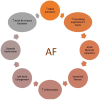Multidisciplinary Approach in Atrial Fibrillation: As Good as Gold
- PMID: 39200763
- PMCID: PMC11354619
- DOI: 10.3390/jcm13164621
Multidisciplinary Approach in Atrial Fibrillation: As Good as Gold
Abstract
Atrial fibrillation (AF) represents the most common sustained arrhythmia necessitating dual focus: acute complication management and sustained longitudinal oversight to modulate disease progression and ensure comprehensive patient care over time. AF is a multifaceted disorder; due to such a great number of potential exacerbating conditions, a multidisciplinary team (MDT) should manage AF patients by cooperating with a cardiologist. Effective management of AF patients necessitates the implementation of a well-coordinated and tailored care pathway aimed at delivering optimized treatment through collaboration among various healthcare professionals. Management of AF should be carefully evaluated and mutually agreed upon in consultation with healthcare providers. It is crucial to recognize that treatment may evolve due to the emergence of new risk factors, symptoms, disease progression, and advancements in treatment modalities. In the context of multidisciplinary AF teams, a coordinated approach involves assembling a diverse team tailored to meet individual patients' unique needs based on local services' availability.
Keywords: atrial fibrillation; multi-integrated approach; multidisciplinary team.
Conflict of interest statement
The authors declare no conflicts of interest.
Figures









References
-
- Steinberg B.A., Kim S., Fonarow G.C., Thomas L., Ansell J., Kowey P.R., Mahaffey K.W., Gersh B.J., Hylek E., Naccarelli G., et al. Drivers of hospitalization for patients with atrial fibrillation: Results from the Outcomes Registry for Better Informed Treatment of Atrial Fibrillation (ORBIT-AF) Am. Heart J. 2014;167:735–742.e2. doi: 10.1016/j.ahj.2014.02.003. - DOI - PMC - PubMed
-
- Kirchhof P., Ammentorp B., Darius H., De Caterina R., Le Heuzey J.Y., Schilling R.J., Schmitt J., Zamorano J.L. Management of atrial fibrillation in seven European countries after the publication of the 2010 ESC Guidelines on atrial fibrillation: Primary results of the PREvention oF thromboemolic events--European Registry in Atrial Fibrillation (PREFER in AF) Europace. 2014;16:6–14. doi: 10.1093/europace/eut263. - DOI - PMC - PubMed
-
- Hindricks G., Potpara T., Dagres N., Arbelo E., Bax J.J., Blomström-Lundqvist C., Boriani G., Castella M., Dan G.-A., Dilaveris P.E., et al. 2020 ESC Guidelines for the diagnosis and management of atrial fibrillation developed in collaboration with the European Association for Cardio-Thoracic Surgery (EACTS): The Task Force for the diagnosis and management of atrial fibrillation of the European Society of Cardiology (ESC) Developed with the special contribution of the European Heart Rhythm Association (EHRA) of the ESC. Eur. Heart J. 2021;42:373–498. - PubMed
Publication types
LinkOut - more resources
Full Text Sources
Research Materials

